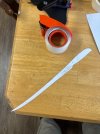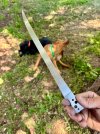Hey yall---pleasehelp--
I wanna make a fillet knife---I was gonna order some steel blanks of 1095
Ive made several knives out of 1095 and really like it--I know it can rust and I take care of them--
1-PLEASE tell me what thickness of blank I need to order (Im guessing1/16)--
2-If 1095 isnt a good steel that will flex a bit--please tell me another easy steel for a newbie--
THANKS!!!
I wanna make a fillet knife---I was gonna order some steel blanks of 1095
Ive made several knives out of 1095 and really like it--I know it can rust and I take care of them--
1-PLEASE tell me what thickness of blank I need to order (Im guessing1/16)--
2-If 1095 isnt a good steel that will flex a bit--please tell me another easy steel for a newbie--
THANKS!!!


